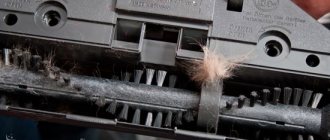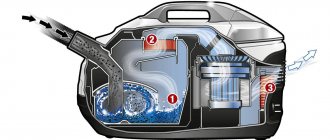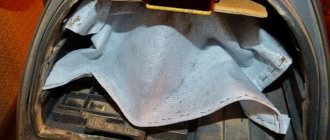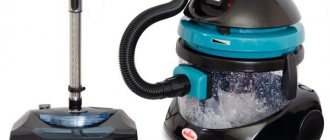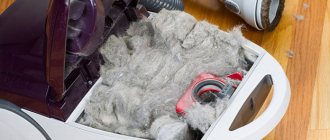A broken home vacuum cleaner can dramatically change your plans, ruin your mood, and even reduce your family budget. However, you shouldn’t immediately jump on the bandwagon and go looking for a more reliable replacement. You can try to repair the unit at home. This solution to the problem will save a considerable amount, don’t you agree?
Let's find out how to disassemble a Samsung vacuum cleaner in order to independently return it to functionality. The design of many cleaning units is similar, so the proposed instructions can also be used when repairing models from other manufacturers. The main thing is to act carefully and without haste.
Step-by-step instructions for disassembling the engine
The next step in repairing a Samsung vacuum cleaner is to inspect and repair the device’s motor.
To repair the motor of a Samsung vacuum cleaner, you first need to disassemble it. This is done as follows: Using a screwdriver, unscrew the two side bolts located at the top of the case. Turn the body a little and look at the engine. If you try to remove it, you will find that the coil is preventing you from doing so.
Carefully free the engine from its wires and disconnect all connectors. Carefully remove the coil wires so that the coil itself remains on the body, and remove the motor. After the engine is removed, you need to repeat the cleaning again. Now you need to remove the sealing rubber. To do this, you need to unscrew the two side bolts. Using a screwdriver, the two halves of the engine housing are separated. Next, the engine itself is removed from the plastic housing. Look at the top of the engine
You will see rolling. They need to be bent in the opposite direction. Then a screwdriver is stuck into any gap. Both halves are separated from each other. This way the turbine is freed from the housing. Using a 12mm socket, the bolt is unscrewed. What is important: the thread is left-handed, so when removing the bolt, it must be turned clockwise. In this case, the engine stator must be jammed with small wooden blocks. The entire structure must be supported. Now you can remove the turbine. Remove the washer and unscrew the two bolts. At the bottom you will find four more screws that need to be removed. Next you need to remove the brushes, after unscrewing all the bolts. We knock out the anchor. We insert the key into the hole and knock on it with a hammer. The engine will pop out. Pay attention to the bearings. If they are in good condition, they can be coated with oil. We take out the boot with tweezers. If the bearing rotates with a rustling sound and remains dry, it needs to be cleaned and lubricated. You can use carburetor cleaner to clean it.
Reassemble the vacuum cleaner in reverse order.
Your specific model of vacuum cleaner may require different care. Wipe with a lightly dampened cloth and a small amount of cleaner over the plastic parts of the vacuum cleaner. In any case, however, you should regularly clean the outside of your vacuum cleaner. . You must remember that cleaning your air conditioning filters will ensure optimal air conditioning performance as well as normal energy consumption.
Smoke, fire, short circuit
Grab the top panel of the front panel and pull down or lift it to open. Then lift the panel slightly. Hold the handle and lift it up. Then pull the air filter towards you and slide it down. Air cleaning. Washable foam air filter that captures large air particles. The filter can be cleaned by vacuuming or hand washing.
Watch the video below on how to disassemble a vacuum cleaner:
If desired, you can even rewind the stator of the vacuum cleaner motor. See the video below for how to rewind the vacuum cleaner motor:
How to assemble?
To reassemble the vacuum cleaner, you need to perform all the steps in reverse order. The main thing is not to lose or confuse the location of the parts. The hardest part is assembling the motor.
The algorithm of actions is as follows:
- a pressure gasket and a wavy metal ring are put on the shaft with bearings;
- cover the rotor with an impeller and a petal, screw on the brushes;
- crimp the metal cover using pliers;
- install the engine back, connect the contacts.
All that remains is to screw the control board, connecting it to the terminals, insert the cleaned filter and assemble the housing.
How is the problem solved, and is it possible to prevent it?
Why doesn't the vacuum cleaner work? Let's look at some trivial reasons that any user can deal with. Automation failure can occur for the following reasons:
- Filling the dust container. This will be indicated by the presence of a dusty smell.
- Ingress of large debris. Large sizes of dirt stuck in the air duct interfere with the flow of air sucked by the vacuum cleaner.
- Debris stuck in the hose. Evidence of this is a change in sound when the device is turned on.
- Pre-engine filter is dirty. During this process, an unpleasant burnt smell appears.
Let's consider the possibilities of repairing a faulty Samsung vacuum cleaner, and what to do when the vacuum cleaner does not turn on. You can fix the above problems yourself, but it’s still better to avoid them in the first place. To do this, you will need to disconnect the equipment from the power source, then disassemble the device and clean the debris accumulated inside.
To access the dust container, remove the top cover. Some dust containers can be cleaned, or you can replace them with new ones. It is also advisable to wash the dust collector and dry it. In order not to spill dirt and dust, you should close the existing valve for a tight seal. When installing the dust collector back into place, make sure that the neck fits snugly against the bag holder. If this does not happen, then dirt and dust will seep into the structure, which will lead to overheating of the motor and accumulation of dirt on the components.
Filters require additional care. Be sure to read the instructions and find out how many filters are installed in your particular vacuum cleaner model. All filters installed in the structure should be checked. Some types of filters can be washed with running water to clean them. But before installing it in the structure, you should definitely dry it. Starting a vacuum cleaner with a wet filter will cause damage. Periodic replacement is carried out according to the manufacturer's recommendation. When the filter has served its useful life, it is replaced with a new one. The filter life is indicated in the operating book.
All replacement consumables, filters, brushes and other accessories can be purchased at a specialized store.
To remove blockages in the nozzle, unscrew the corrugated accessory from the body, inspect its integrity, remove the accumulated dirt and screw it back. Dirt stuck in the bellows prevents air flow.
But still, if the vacuum cleaner does not turn on, what should you do? If the repair of the breakdown is serious, it is better to contact specialized technicians who can solve this problem.
But it is worth remembering that the main possible breakdowns occur due to engine overheating. You should adhere to the following rules:
- To prevent overheating, use the vacuum cleaner for no more than 30 minutes when cleaning. At maximum mode, use the device for no more than 10-15 minutes. Longer operation may lead to overheating; to do this, allow the device to rest and cool down.
- Make sure the dust bin is full to remove accumulated dirt and dust. An excess of dirt and dust will not allow air flow to pass through, which will lead to overheating of the electric motor. Also, an excess of dust in the dust collector will lead to clogging of the structure inside the device.
- Clean the pre-motor protection filter in a timely manner. Excessive contamination can lead to the formation of an unpleasant burnt odor.
- Avoid sucking large objects that may block the blower. Before using a vacuum cleaner to clean the floor covering, you should collect large debris and accidentally fallen items by hand.
- You need to monitor the level of noise produced. If the sound changes, this may indicate a clogged brush or bellows accessory.
Monitor the performance of your home assistant, and provide timely care for the vacuum cleaner and its replacement consumables. Then it will be easier to avoid breakdowns of equipment to maintain cleanliness in the house.
How to clean the filter element in a Samsung device?
To ensure the highest quality cleaning, modern Samsung vacuum cleaners are equipped with a multi-stage filter system consisting of:
- bag (container) for collecting garbage,
- coarse and fine filters.
In order for a household appliance to operate without interruption, each filter must be cleaned promptly and correctly.
Cyclone (with dust container)
A cylindrical plastic container with a lid and handle, into which dust and debris from the air settles under the influence of centrifugal force, is called a cyclone filter (in Samsung vacuum cleaners, it is fixed on the side of the body).
Cleaning the flask is very simple:
- Disconnect the device from the electrical network.
- Pull the container out of the vacuum cleaner body by the handle.
- Open the container, shake out the debris and dust.
- Using a soft sponge and soap solution, clean the walls of the container from dirt and rinse it under running water.
- After waiting for the container to dry completely, cover it with a lid and place it in its original place.
If water gets into the cyclone filter during cleaning, the household appliance must be turned off immediately, the container removed and cleaned. Otherwise, dust and debris, mixed with water, will be compressed and clog the filter element, which significantly reduces the suction power of the vacuum cleaner.
The process of cleaning the filter is in the video:
Aquafilter
The air filtration system using water (aquafilter) is a container partially (1/3) filled with water inserted into the body of the vacuum cleaner. Passing through the aquafilter, dust from the air is moistened and settles at the bottom of the container.
To clean the aqua filter, you need to:
- remove the container from the body of the household appliance;
- open the container;
- pour out dirty water;
- Rinse the container under running water.
The water filter is cleaned after each cleaning. Otherwise, you will have to make a lot of effort to get rid of the musty smell of stagnant dirty water.
NERA
The HEPA fine air filter traps the smallest (up to 0.6 microns) dust particles. You can find the HEPA filter on the back panel of the vacuum cleaner behind a special grille (it looks like a dense accordion made of fibrous or polymer materials, placed in a plastic frame).
To clean the HEPA filter, you need to carry out a series of sequential steps:
- disconnect the vacuum cleaner from the electrical network;
- open the grille hiding the filter element;
- remove the filter accordion from the plastic housing;
- Gently clean the filter with a soft brush, then rinse under running water.
After cleaning, the filter accordion must be thoroughly dried. Only after drying is it placed back into the plastic case and then into the vacuum cleaner.
Foam rubber
A fine filter made of foam rubber is installed in front of the motor of a Samsung vacuum cleaner. Caring for the foam filter element is very simple:
- Disconnect the household appliance from the electrical network.
- Open the lid of the vacuum cleaner, take out the garbage collection bag (in some models, a plastic container is installed instead of a bag).
- Under the dust collector there is a plastic frame with a handle, into which a foam filter element is inserted.
- Remove the filter, moisten it with water, soap it with laundry soap, and rinse under running water.
- The well-dried part is returned to its original place.
To prevent the foam from tearing and retain its shape, it should not be squeezed, stretched or twisted after washing. The foam must be carefully laid out on a flat surface and allowed to dry naturally.
Carbonic
Samsung premium vacuum cleaners are equipped with a special carbon filter. This plastic form, filled with pressed carbon granules, traps not only dust particles, but also unpleasant odors (interestingly, the filter continues to work even when the vacuum cleaner is turned off).
Even though the carbon filter is quite expensive, it can only be used once. The maximum that can slightly extend its service life is cleaning small dust particles from the outside of the case with a soft brush.
Preparatory stage of disassembling the Samsung vacuum cleaner
You can notice the problem if you have been using the equipment for some time. You know what sound is typical of your Samsung and the smallest changes in it or in the operation of the device will be noticeable to you.
The breakdown of many parts will lead to financial problems.
A broken motor in a vacuum cleaner is noticeable by: intermittent sounds, throws out dust, smells burnt. If it is not possible to give it to a specialist, then disassembling a Samsung 1800 w vacuum cleaner with your own hands, videos and photos will be assistants.
What tools will you need?
Need to clean the dust bag or replace it? No special equipment or skills are needed. They are needed in cases of problems with the motor, wires, and board elements. They will be:
- file;
- awl;
- pliers;
- sandpaper;
- vice;
- construction knife;
- spare connectors and wiring.
Use tools to disassemble the vacuum cleaner.
In cases of replacing small parts you won’t have to spend a lot
But to replace a large and expensive component, you can pay attention to an alternative. With the condition of good material from which it is made
Conclusion
The instructions presented above will help in a force majeure situation when it is not possible to call a professional. If you went, for example, to the country, then disassembling a Samsung vacuum cleaner will become a serious test for the uninitiated. If you are in a large city, you should not neglect the services of craftsmen, even in order to save money. Not every craftsman will be able to disassemble and reassemble an electric motor without consequences. Is it worth experimenting with expensive equipment if you don't have an engineering background? Make decisions based on experience and common sense.
Case disassembly
The upper part of the body is secured with self-tapping screws. Unscrew them with a screwdriver and screwdriver to remove the cover. If you are removing the dust container, also unscrew the screws underneath it.
The main part of the case is held on by self-tapping screws or special latches. After removal, access to the motherboard opens. If you are sure that the board is operating normally, move it aside to avoid damage during diagnostics and repairs. To do this, disconnect its connectors and unscrew the screw in the central part.
Next to the engine there is a check valve - a small button that can be pulled out quite simply. The valve is needed to stop the engine if it becomes clogged due to strong suction force. Without a valve, the electric motor may burn out.
To access the engine itself, remove the bolted casing and rubber surrounds. There may also be protective pads made of foam rubber or felt next to the motor. They secure the position of the engine and do not allow it to touch the walls of the casing.
The process of cleaning the insides, the better
An unpleasant smell and hum of a vacuum cleaner while cleaning a room may be due to the accumulation of dust on the inside of this device. For cleaning, soft-bristled brushes, a medium-power vacuum cleaner with a special attachment, and viscose wipes are used.
Is it possible to do wet processing?
Cleaning the inside of the vacuum cleaner is carried out using dry methods that do not disturb the circuit board tracks that conduct current. To do this, use a thin soft brush or a room fan. If dry cleaning does not allow you to cope with contaminants, then wet processing is used, but all parts are dried as quickly as possible.
Plastic parts are washed under running water. Assembly is carried out after all elements are completely dry. Dry cleaning helps remove dirt from the motor housing, drum and cable. If the casing cannot be cleaned with a brush or vacuum cleaner, then you can resort to a damp viscose cloth, but moisture should not get into the circuit.
Step-by-step disassembly sequence
Here we will tell you how to get to the vacuum cleaner motor and consider the disassembly process in more detail.
Disconnect the hose and disassemble the housing
As a rule, you need to use a long Phillips screwdriver to unscrew the four bolts holding the two halves of the case together. Sometimes you will have to remove some overhead elements, for example, a turbine. The main thing is not to damage anything and unscrew all the bolts before separating the body parts.
Removing the motor
Before removing the motor, disconnect the power terminals and other electronics.
Removing the engine cover
The lid is seamed around the entire perimeter. To remove it, gently press out the seam with pliers. When exposed to light impacts, the cover should separate from the main body.
We take out the brushes by unscrewing the holding screws
As a rule, the brushes are pressed to the rotor by small springs - if you unscrew the clamps, the springs can fly out in an unknown direction.
Check the carbon brushes for wear: they should fit evenly and tightly to the motor commutator and be of sufficient thickness. The thickness must be compared with the depth of the grooves into which they are inserted on the engine, having previously measured it with a caliper.
Some motors do not have brushes at all: these are brushless motors with an asynchronous motor and a squirrel cage rotor. They are rare, but if you do not find brushes on your vacuum cleaner, do not be surprised and continue disassembling.
Unscrew the rotor mounting nut
To remove the fastener, first spray it with WD-40 or similar. Then make clamping bars in place of the brushes so that the commutator (the part of the engine between them) does not turn when unwinding. The size and shape are the same as the brushes, but slightly longer so that the bars protrude from the body.
Clamp the manifold with blocks using a vice or clamp. After this, the nut can be easily unscrewed clockwise with a wrench.
Disassembling the air pump wheel
The procedure greatly depends on the brand of the model and, as a rule, does not cause difficulties. The main task is to free the working shaft of the electric motor. Look carefully at how the working tool is mounted on the shaft, to see if it has additional fastenings in the form of screws or cotter pins. Carefully remove everything and remove. As a rule, there are friction washers on the shaft along with the wheel, which also need to be treated with WD-40.
We carefully inspect the rotor, stator and bearings for damage
If the bearings are worn out, the guide mounts often become loose due to vibration. Check - if everything is in order, move on. If a bearing fails, do not try to repair it: take it for repair or replace it with a new one. In specialized stores, sellers will 100% find an analogue, the main thing is not to throw away the part that has fallen apart.
The windings or their insulation may be damaged—scuffs or burnt insulating varnish are visible. Ideally, you would test the winding with a multimeter (more on this below).
Disassemble the engine further so that the armature can be rewound. If everything is fine with the windings and only the bearing is broken, try assembling the device and turning it on after replacing the bearing.
If there are no obvious burn marks on the winding, it may be intact and there is no need to rewind. But if there are abrasions with a metallic sheen of copper, it is better to be safe.
If the bearings are damaged: how to remove them
In a good way, a special puller is needed here, but the bearing races can be removed from the shaft using a screwdriver and a hammer. The main thing is to do everything carefully and take your time: the impacts on the bearing races should not be too hard.
If the windings are damaged: how to disassemble the armature
To disassemble the anchor, you need to rewind the motor. It is very difficult to rewind at home, so we recommend that you take the part to professionals.
Let's summarize the instructions with another example in the video:
Troubleshooting other problems
If the working vacuum cleaner has weakened suction power, the cause of the malfunction is clogged filters. Moreover, cleaning the dust bag or container, as well as the foam plate behind it, will not be enough. You need to remove the filter on the exhaust of the vacuum cleaner. It is usually made of paper or artificial fiber. The filter is carefully cleaned with a dry brush. They are trying to blow it off or shake it off.
When the problem is not solved, disassemble the vacuum cleaner, remove the motor and clean the impeller. If the blades are clogged with dust, then the suction has weakened for this reason.
The vacuum cleaner does not work well due to wear on the brushes and contamination of the armature commutator. After complete disassembly of the electric motor, the conductive copper plates are cleaned with zero-grade sandpaper. New brushes are installed and the screw contacts are retightened.
The reason the vacuum cleaner does not work may be a faulty power cable or power button. The elements can be easily measured with any cheap multimeter. If testing does not give positive results, the problem is in the electronic unit. They just change it.
Problems with the electronic unit result in the inability to use the wheel to adjust the engine speed, which affects the suction force.
When the vacuum cleaner stops winding the power cable, you need to get to the drum. A common cause of failure is spring stretching. Sometimes it bursts. In the first case, the tension force is restored to the spring by unwinding or winding the wire. In the second case, they buy a new drum.
Disassembling a Samsung vacuum cleaner is scary only for the first time. After the first repair, subsequent disassemblies will occur faster.
5 best cordless vacuum cleaners
5 best container vacuum cleaners 5 best BORK vacuum cleaners 6 best Polaris vacuum cleaners How a washing vacuum cleaner works: additional functions How a vacuum cleaner works: functions of a household appliance How a robot vacuum cleaner works: device and additional features
How to make a vacuum cleaner from a bottle with your own hands: step-by-step assembly instructions The vacuum cleaner does not suck up dust well: how to find the problem and make repairs
How to disassemble and clean the turbo brush
It is advisable to clean this vacuum cleaner attachment more thoroughly once every six months. To do this you need to disassemble it:
- Remove the protective cover.
- Turn the nozzle over. On the inside you will see 6 screws. Unscrew them using a screwdriver.
- Carefully separate the brush into two halves.
- Wipe the inside surface with a clean cloth. Hard-to-reach places can be cleaned with a vacuum cleaner pipe.
- Remove hair, fur and dirt from all parts of the mechanism. To do this, you can use the same tweezers and scissors.
- Collect the brush.
That's the whole cleaning process. In principle, this is not difficult to do even without outside help. If there are pets in the house, then the nozzle will have to be disassembled every 3 months, then it will be able to work with maximum power.
“Cleanliness is the key to health.” This is not just a slogan. This is a correct and relevant statement.
Today, various devices help to restore order, invented not only for “lazy people,” as the joke goes, but in general for convenience and ease of work.
Sequence of disassembling a vacuum cleaner using the example of Samsung 1600w
Disassembling any equipment begins with preparation. And the right sequence. We cannot reach the heart of the device until we remove everything that covers it.
You can disassemble the vacuum cleaner yourself using the instructions.
You can open it like this:
- Disconnect anything that might be in the way and unscrew the case. Use a screwdriver to unscrew all the screws, including the hidden ones that may be near the buttons. After unscrewing all the parts that can hold the shell of the vacuum cleaner, remove it. If it doesn't work, look again to see if there are hidden latches.
- Disconnect the electrical installation. You can see it on the connectors.
- We remove the engine from the entire plastic body by unscrewing it from the frame.
Correct diagnosis is the key to success.
Engine disassembly
The heart of the vacuum cleaner has a step-by-step opening process.
- First you need to remove the impeller. But for this you need to perform certain actions. Remove the front part of the casing. Use a thin screwdriver to bend the side of the casing so that the screwdriver gets inside. Pull back the top of the casing and the impeller becomes accessible.
- Unscrew the nut on the impeller.
- We remove the housing screws, but by this time the brushes need to be removed.
- Pull out the anchor.
- Use thread pullers to remove the bearing.
Filters become clogged, debris is poorly drawn in, there is additional load on the motor and eventually it breaks.
Types and causes of engine breakdowns
If the unit completely refuses to work, the problem may be in the power supply system. If the electrical circuit and brushes are in good condition, damage to the motor windings may occur. Low speeds, excessive noise and vibration indicate problems with the bearings holding the armature. Faulty current collectors and worn brushes cause sparking.
A common cause of engine failure is turbine overload. In continuous mode, the vacuum cleaner should work for about 30-40 minutes. With longer loads, as a result of overheating, some materials in the motor lose their properties, and it fails. Housewives who are not very attentive rarely clean the dust collection bag and do not monitor the condition of the filters, which also leads to overheating. Sometimes foreign objects get into the hose and interfere with free suction - this is another reason for overloading the motor.
The penetration of moisture has an adverse effect on the engine. The turbine mainly consists of metal parts and is therefore susceptible to corrosion. In addition, under the influence of moisture, dust particles form on the blades, which over time complicate the operation of the turbine.
One of the most common causes of engine breakdowns can be considered voltage surges in our electrical networks. One voltage surge is sometimes enough to completely damage the motor. In some cases, the turbine may partially burn out. The pump will continue to work, but will not last long. Not only high voltages, but also low voltages are dangerous for electrical appliances.
To eliminate any problems that have arisen, it is necessary to disassemble the engine of the unit. Before proceeding with dismantling, you should familiarize yourself with the location of the individual fastening parts. Disassembling this household appliance is not particularly difficult, but it does have some subtleties. In general, despite the very large number of brands and models, all vacuum cleaners with minor deviations are equipped with the same motors.
Preventive measures
It is better not to treat the problem, but to prevent it. This applies to everything and vacuum cleaners too. How does she look? Basic care: replace or empty the dust bag on time.
Each technique has its own weaknesses.
An important detail is the brush. Cleaning its lint should also not be a waste of time. If the vacuum cleaner is intended for dry cleaning, do not suck in water and other liquids, they will accumulate inside. This leads to breakdown.
Clean your vacuum cleaner more often to increase its shelf life.
Keep the warranty receipt after purchasing the vacuum cleaner, if you have one. Most types of breakdowns can be repaired by specialists. If it is missing or there is another type of breakdown, do not be afraid to use videos from the Internet, where craftsmen will tell you how to repair a broken Samsung vacuum cleaner with your own hands.
Disassembling the case
The difficulty of disassembling the case lies in the presence of hidden bolts. The manufacturer hides them under buttons, covers and other parts. Repair work begins with preparing the tool. You will definitely need a set of straight and shaped screwdrivers.
Moreover, now we often see screws not for a Phillips screwdriver, but for a triangular or asterisk one. To test the wires, fuse, and switch contacts, you need a multimeter. It is advisable to have tweezers on hand for grasping small screws.
If you plan to disassemble the electric motor, you will need a bearing puller, a hammer, and a set of wrenches of sizes from 8 to 17 mm. Materials needed include Litol lubricant, WD-40 rust-corroding liquid, new bearings and brushes.
Disassembling the case begins by unscrewing all visible screws. Samsung usually doesn't hide them. The approximate location of the screws is shown in red circles in the photo, but each model may vary. If the top cover of the case cannot be removed, it means that there is still a hidden fastener somewhere. Moreover, these may not be screws, but latches on the case.
After disconnecting the top cover from the bottom of the case, do not rush to remove it abruptly. There may be wires coming from the electronic unit. To avoid breaking them, the chips are disconnected on the board. Now you can carefully remove the cover. The review includes an electric motor with wires, as well as other electrical parts located inside the lower half of the housing.
The top cover with screws is set aside so that nothing gets lost.
Required Tools
The set of tools needed will depend on the type and model of Samsung vacuum cleaner. When disassembling and repairing, preventing or cleaning the device, as well as its individual elements, you cannot do without the following devices:
- Phillips and slotted screwdrivers - their sizes are selected in accordance with the type and depth of the screws;
- pliers;
- a stationery knife, or better yet a professional construction knife;
- lubricant;
- electrical insulating tape;
- electrical tester.
The type of work performed will largely influence the choice of tools. For example, to clean the surface of a suction hose before gluing cracks, you will need sandpaper and a degreaser (acetone, solvent). It is convenient to remove dirt on the shaft of the vacuum cleaner brushes with scissors, but to remove blockages you will have to use a long, stiff wire. For gluing cracks or chips on the body, universal super glue is suitable, but for moving parts, such as a hose, a more elastic adhesive material is needed.
Reasons for disassembling the vacuum cleaner motor
The motor unit of a vacuum cleaner, in turn, consists of 2 fundamental mechanisms:
- Commutator motor;
- Fan.
The fan is attached to the rotation shaft, due to which the suction process takes place. As a rule, the main reason for motor failure is neglect or long-term use.
Manufacturers of household appliances solved the problem with the first option by installing a thermostat that shows the temperature on modern models. The electric motor for the LG vacuum cleaner has this device. When the critical temperature is reached, the thermostat automatically turns off the unit. To continue using the unit, you should leave it for a while until it has cooled down properly.
Another question that owners of household appliances are interested in is “Why do brushes spark?” Like rapid overheating, as well as a strong hum, this problem also applies to a malfunction of the vacuum cleaner. In such cases, the best solution is to replace the motor. But there are situations when the vacuum cleaner engine can still be saved and rehabilitated. These include: rapid loss of suction power. Do not rush to conclusions; perhaps the power drops due to the neglected condition of the filters and brushes. You should always check the equipment first. By the way, repairing an electric motor armature, depending on the level of depreciation, costs 70% of the cost of a complete motor, so it is recommended to purchase a new one.
Although, on the other hand, the design of household vacuum cleaners from different manufacturers is similar, so trying to fix a vacuum cleaner at home is still worth a try.
The principle and design of the vacuum cleaner
The choice of vacuum cleaners is expanding. Main options:
- For dry cleaning;
- with aquafilter;
- washing vacuum cleaner.
The most common and lightweight is a dry cleaning vacuum cleaner. The operating principle of modern vacuum cleaners and old ones is the same.
After starting, all debris is sucked out using a vacuum fan. Once inside, the garbage goes through several stages of filtration. Often, this is: at the debris inlet, in the engine part, and at the outlet. Each stage protects the vacuum cleaner from damage by large particles.
The first sign that the filter is clogged is that the suction power drops.
All dust and dirt are collected in a special bag. They can be reusable and replaceable from paper. There are models of vacuum cleaners that use a container system instead of a bag. All the dirt settles on the walls of the container, and then purified air also comes out.
Sequence of disassembling a vacuum cleaner using the example of Samsung 1600w
Disassembling any equipment begins with preparation. And the right sequence. We cannot reach the heart of the device until we remove everything that covers it.
You can disassemble the vacuum cleaner yourself using the instructions.
You can open it like this:
- Disconnect anything that might be in the way and unscrew the case. Use a screwdriver to unscrew all the screws, including the hidden ones that may be near the buttons. After unscrewing all the parts that can hold the shell of the vacuum cleaner, remove it. If it doesn't work, look again to see if there are hidden latches.
- Disconnect the electrical installation. You can see it on the connectors.
- We remove the engine from the entire plastic body by unscrewing it from the frame.
Correct diagnosis is the key to success.
Engine disassembly
The heart of the vacuum cleaner has a step-by-step opening process.
- First you need to remove the impeller. But for this you need to perform certain actions. Remove the front part of the casing. Use a thin screwdriver to bend the side of the casing so that the screwdriver gets inside. Pull back the top of the casing and the impeller becomes accessible.
- Unscrew the nut on the impeller.
- We remove the housing screws, but by this time the brushes need to be removed.
- Pull out the anchor.
- Use thread pullers to remove the bearing.
Filters become clogged, debris is poorly drawn in, there is additional load on the motor and eventually it breaks.
Repairing Samsung vacuum cleaners at home
Disassembly of the Samsung 1800w vacuum cleaner and other models is carried out only in case of minor damage. More complex situations will require specific tools that not everyone has. In this case, the repair of such equipment is carried out by a person who has similar work experience. Step-by-step process for repairing a vacuum cleaner:
- Inspect the engine from the inside: remove all layers of insulating winding from the metal surface.
- Check the integrity of the metal box itself and its parts, wipe off dust on the inside of the engine.
- Connect both wires in turn to the electrical network.
- If a wire breaks, strip both ends and pick up a terminal to crimp.
There are many videos on how to disassemble a Samsung vacuum cleaner. In order not to get confused in the sequence during assembly, it is worth filming the entire process.
Engine disassembly
Since the majority of vacuum cleaner malfunctions arise from the motor, it often has to be disassembled to repair it.
This process is not difficult and looks like this. Using a thin screwdriver, carefully remove the impeller casing. As a result, access to the nut securing it opens. After unscrewing this nut, you need to remove the motor brushes and unscrew the housing coupling screws
All that remains is to carefully remove the armature, and you can begin removing the bearings. As a result of the work done at the workplace, you should get something like this (pictured)
To remove bearings, the available tools are usually sufficient, but sometimes a special puller is required. After disassembly, all parts are thoroughly cleaned of dust and dirt.
Particular attention is paid to the bearing seating surfaces and the engine manifold
Removing the brushes
Place a screwdriver on the fastening screw one by one and turn it out.
We carefully remove the brush by hand and inspect it.
Traces of soot with the formation of layers of graphite dust are visible to the naked eye.
The same picture is observed on the second brush. Traces of sparking are clearly visible on the end surface.
This allows us to conclude that an external inspection of the commutator and an electrical check of the condition of the rotor and stator windings are necessary.
This cannot be done through a closed engine casing: it requires disassembly and removal of the armature.
Sequence of disassembling a vacuum cleaner using the example of Samsung 1600w
Disassembling any equipment begins with preparation. And the right sequence. We cannot reach the heart of the device until we remove everything that covers it.
You can disassemble the vacuum cleaner yourself using the instructions.
You can open it like this:
- Disconnect anything that might be in the way and unscrew the case. Use a screwdriver to unscrew all the screws, including the hidden ones that may be near the buttons. After unscrewing all the parts that can hold the shell of the vacuum cleaner, remove it. If it doesn't work, look again to see if there are hidden latches.
- Disconnect the electrical installation. You can see it on the connectors.
- We remove the engine from the entire plastic body by unscrewing it from the frame.
Correct diagnosis is the key to success.
Engine disassembly
The heart of the vacuum cleaner has a step-by-step opening process.
- First you need to remove the impeller. But for this you need to perform certain actions. Remove the front part of the casing. Use a thin screwdriver to bend the side of the casing so that the screwdriver gets inside. Pull back the top of the casing and the impeller becomes accessible.
- Unscrew the nut on the impeller.
- We remove the housing screws, but by this time the brushes need to be removed.
- Pull out the anchor.
- Use thread pullers to remove the bearing.
Filters become clogged, debris is poorly drawn in, there is additional load on the motor and eventually it breaks.
Minor faults and their elimination
If the vacuum cleaner begins to act strangely - to perform its functions incorrectly, to make loud noise, to vibrate - it needs help.
Most often, the cause of the malfunction is the cleaning process itself: the dust bag is completely filled or one of the filters is clogged with debris.
Some vacuum cleaners are easy to disassemble, while others require certain knowledge. To avoid mistakes, we recommend that you often look at the instructions, which are equipped with diagrams and tips.
Usually you can solve the problem on your own. But if you are not good at repairing equipment, it is better to take the device to a service center, to specialists.
Problem #1 - suction power has dropped sharply
If you notice that dust is poorly absorbed, and small debris remains completely untouched on the floor, you will have to find out the reason through partial disassembly. First you need to make sure that everything is in order with the pipe, hose and brush.
Procedure:
- disconnect the hose from the vacuum cleaner;
- separate the pipe from the hose;
- remove the nozzle;
- carefully inspect each part;
- try to blow out the pipe and hose.
If a large object (a plastic bag, a sock, a sheet of paper) gets into one of the elements, you need to carefully remove it, then reassemble it in the reverse order and try to start the device.
Sometimes the traction weakens simply because you accidentally touched the power regulator and set it to minimum. Be sure to check it before any disassembly.
Problem #2 - the vacuum cleaner filters are clogged
Unusual sound, weak traction, stoppage of operation - the consequences of clogged filters. For devices with a fill indicator, this can also be determined by the red light coming on. Modern devices provide everything to ensure that filters can be accessed quickly and easily.
Usually there are two main elements that need to be cleaned - a plastic cyclone filter (a transparent reservoir with compartments) and a sponge enclosed in a plastic container. But sometimes it is necessary to replace the HEPA filter, and for washing units - additional engine protection.
Photo tips for disassembly, cleaning and replacement:
Image gallery Photos from
To get to the fine filter, you need to remove the cover located at the back of the device
If the filter is clean, then the reason is not in it - we install it in place. It is better to replace a dirty part with a new one, although some try to wash it
The finest dust remains in the sponge filter. It is usually inserted into the reservoir lid and enclosed in a small plastic container. The sponge washes well with soapy water
Container with cyclone filter
Plastic grille to protect the HEPA filter
New HEPA filter for Samsung
Sponge filter in container
As you can see, disassembling a Samsung vacuum cleaner to clean the filters is simple and quick. The elements are washed in warm water with a non-aggressive detergent. Then they need to be dried and reassembled.
Problem #3 - the device does not turn on
The standard test when the device is not working is to plug it into the network. Make sure the power cord is plugged into the outlet and the power control button is set to the correct setting.
If the indication does not work and the vacuum cleaner does not make noise, most likely the motor will have to be repaired or replaced. But problems with the board are also possible, so disassembling the case is necessary in any case.
How to repair a vacuum cleaner with your own hands
In order to repair all the elements with your own hands on a Samsung vacuum cleaner, you need to determine the place where it formed. The motor may need to be disassembled if: there is a burning smell, poor dust suction power. Follow the sequence when removing the housing.
The hose in vacuum cleaners often gets clogged.
The cause of this breakdown is often poor performance of the brushes on the motor. You need to pay attention to them. If the hose or brush is clogged. We clean them. First, remove the brush and check how the hose pulls without it.
You can replace the vacuum cleaner tube with a new one.
If everything is fine, then you need to clean the brush. If not, you can remove the hose and do the same steps. Often, a large item can get stuck inside: a chain, a watch. Clogged filters and waste container.
You do not necessarily need to replace the filters in your Samsung vacuum cleaner if the device begins to work poorly.
To determine, we take everything out and check the draft of the vacuum cleaner. If everything is in order, clean the filters. As for replacing and repairing the motor, here you need to evaluate your skills and abilities. An example of this could be a broken motor winding. To determine problems with it, you need to have the ability to use a multimeter.
The filter must be washed regularly and replaced every two years.
Only with its help can you identify the problem. Other problems that you can solve yourself include:
- Button failure;
- Broken wire in the extension cord;
- Poor contact at brush terminals and winding.
When it comes to engine repair, then you need to evaluate your strengths and financial capabilities. It's easier to buy a new component, although buying bearings is much cheaper if they are the issue.
Check the terminals on the brush.
Checking the motherboard
The control board in a vacuum cleaner does not look the same as in a computer. This is a triac. From the part to the motor there are 2 wires on one side and on the other 2 wires are attached to the socket. The triac itself is located between them.
Only a specialist can repair the motherboard.
Remove it and connect the motor to the wires from the outlet. If everything is in order, you just need to replace the board. Some owners use a vacuum cleaner without it.
Cleaning the vacuum cleaner
The vacuum cleaner also needs to be cleaned. Starting with the lint you use to vacuum, and ending with the insides. Empty your dust bag promptly, whether it's a reusable bag or a disposable one. If you were removing construction dust and it was clogged, after removing all the parts, you can clean the insides.
An odor may occur if the dust container is full and has not been emptied for a long time.
It is convenient to do this with another vacuum cleaner, but carefully. You should be careful with the boards. Do not use the wet cleaning method.
The principle of repairing a household appliance
In order to repair a Samsung vacuum cleaner yourself, you should read the instructions for its operation.
First you need to unplug the power cord from the outlet, pay attention to external signs to determine the location and nature of the breakdown.
In a modern vacuum cleaner, the motor is fully cooled with purified air. On the body, the detachable parts are connected using screw clamps with six self-tapping screws, two of which hold the front part of the fastening cover, and four are located on the opposite side. The handle is secured from the bottom with two self-tapping screws, and the end is held in place by the same number. The electronic motor control board is covered with the top cover of the housing and secured with four plastic locks with latches (grooves with protrusions).
The repair method for a Samsung vacuum cleaner is simple and easy to understand. You should first prepare the necessary tools:
- Several different screwdrivers, pliers.
- Different heads with an awl.
- A small hammer, a soldering iron with a clean rag.
- A supply of WD-40 fluid, EP-2 or Litola-24 lubricant.
- A tester that is necessary to perform continuity testing of electrical circuits.
- Camera.
Prevention of vacuum cleaner breakdowns
To increase the service life of equipment, proper care should be taken. Regular fault prevention ensures high-quality and uninterrupted operation of the unit, and also prevents sudden breakdowns or failures during use.
Periodic visual inspection of the device will allow you to identify worn parts and components and replace them in time. Timely replacement of spare parts is necessary in order to avoid more serious damage to other parts.
Preventative engine care
Caring for the electric motor and early diagnosis of faults prevents possible malfunctions in the operation of the equipment.
It is recommended to disassemble the engine once every 1-2 years, lubricate it, change gaskets, rubber seals, clean filters, and also change bearings when they wear out.
The vacuum cleaner should be disassembled in the following order:
- remove the trash container or bag, filter element;
- unscrew the housing cover;
- clean all parts and mechanisms from a layer of dust;
- Unscrew the bolts and disconnect the engine;
- disassemble it into parts, wash, lubricate, check the condition of the winding, brush-commutator assembly, bearings;
- if necessary, replace worn parts;
- Clean the HEPA filter.
Next, you need to reassemble the device in reverse order.
General recommendations for caring for the unit
Since the main function of a vacuum cleaner is to clean the room from dust, it must be regularly emptied of accumulated debris.
To prevent overheating and damage to components and mechanisms of the device, it is recommended:
- After each cleaning, check the cleanliness of the filters and clean them if necessary;
- Empty the dust bag and garbage container in a timely manner;
- store equipment in a dry place, preventing water from getting on the engine and internal parts;
- Avoid contact with sharp objects that could damage important components of the device;
- observe the operating mode of the unit and do not overheat it.
If problems with the device do arise, follow the above basic recommendations for troubleshooting vacuum cleaner problems.
Problems with improper disassembly
Careless handling of the tool and its use for other purposes may lead to the following problems during disassembly:
- Impeller damage. They are caused by attempts to hold the engine shaft by the impeller while unscrewing the nut.
- Damage to the brush holder. They arise as a result of attempts to jam the shaft by inserting a screwdriver or pliers through the openings of the brush holders without dismantling the brushes.
- Damage to the rotor contact group. The reason is the same - attempts to hold the rotor with pliers or jam with a screwdriver.
To avoid these problems, it is enough to follow the recommendations outlined above.
The main problems of the Samsung 1600w vacuum cleaner
Have you noticed that the vacuum cleaner has started to work worse? If the device begins to suck in dust worse, makes louder noise and vibrates strongly, you should find the cause of the malfunction. Most models of Samsung vacuum cleaners in the mid-price category have a similar device, so similar reasons occur in most of them.
The main causes of breakdowns are:
- A drop in suction power can occur due to mechanical damage to the tube or hose, an object stuck in it, or a malfunction of the motor.
- Clogged filters. If the device has a special indicator, it will light up and you can clean the filter, but if there is no indicator, the main sign of clogged filters will be a decrease in draft and increased noise during operation of the device. In modern models, the filter can be taken out and cleaned very easily.
- The device does not turn on at all or works intermittently. The hum of a working vacuum cleaner becomes intermittent, and it begins to smell of dust or burnt wires. In order to finally make sure that the vacuum cleaner is faulty, try reconnecting it to other sockets - if it still works, then the device needs to be disassembled and the cause of the breakdown is understood.
- The cord does not retract, the plug is faulty, the wires are exposed - this problem can be solved without disassembling the case.
After a brief diagnosis, it is necessary to disassemble the device to find the cause of the breakdown and, possibly, quickly eliminate it.
The most common malfunctions
If it is not possible to take the vacuum cleaner to a specialist to disassemble and assess its condition, you can find out what you need to pay attention to in the event of a malfunction. After problems arise, the first thing to check is the bearings, which help the engine operate.
A specialist can quickly determine the problem of a vacuum cleaner breakdown.
The sound that is characteristic of them: a sharp hum, roar, burning, overheating of the body. In addition to them, attention is paid to the armature and motor brush. A common problem is that the hose does not draw in contaminants.
Vacuum cleaner hoses often fray.
The reason may be a clogged hose, an overfilled dust bag, or a problem with the HEPA filter. A problem that often arises is when the unit draws air, but the debris is not removed properly. The problem may be a worn brush or a broken roller position.
Motor failure is a serious problem.
If the equipment does not turn on and the electricity does not disappear, then the reason lies in: the overheating protection or malfunction of the power circuit, plug, wire, internal wires, or a snag in the switch itself. If the problem occurs with the electronics, it is better to entrust this matter to a professional.
Only a professional service center will quickly repair your vacuum cleaner.
An indicator of this lies in the fact that during operation they discovered smoke, knocked out plugs, and short circuits. This all suggests that the problem is centered on a short circuit inside the device. And frequent problems with collector sparking lead to rapid wear of the device.
Use the drawings to disassemble the vacuum cleaner.
